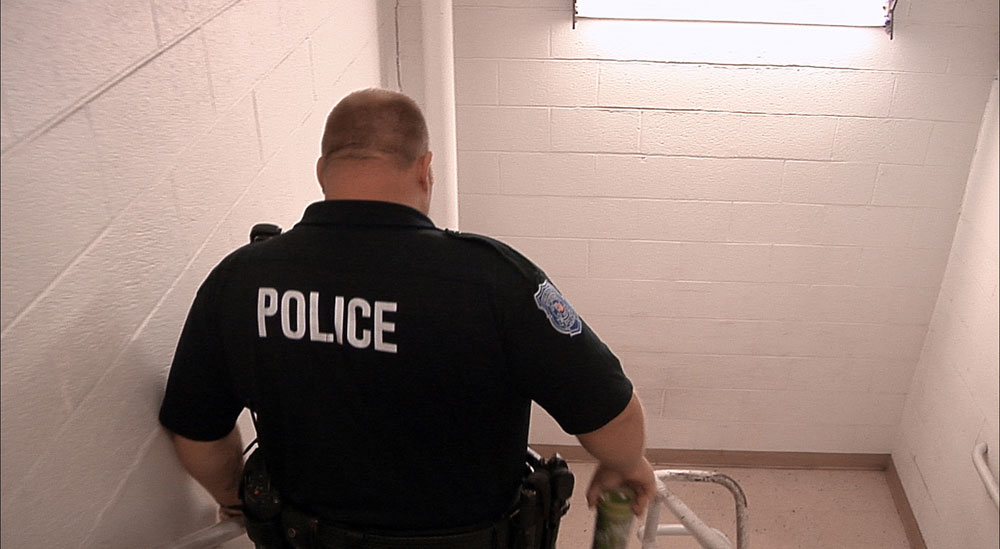It’s hard to think of a more timely film than “Tom Swift and His Electric Rifle,” which arrives in the midst of heightened awareness of police brutality cases around the country, its debut at the Tribeca Film Festival just two days before the death of Freddie Gray in Baltimore while in police custody. Yet it would do a disservice to the extraordinary film that Nick Berardini has made to tie it specifically to one moment or even one subject as he finds so much to cover in the relatively short but compelling history of the Taser, a device presented to police departments across the country as a nonviolent means of incapacitating dangerous suspects yet has increasingly come under fire as more people have died or been seriously injured as a result of being on the receiving end of 50,000 volts of electricity.
Only mere moments into “Tom Swift and His Electric Rifle,” a smiling Steve Tuttle, the Vice President of Strategic Communications at Taser International, is listing off all the wonderful ways electricity has been used to improve people’s lives.
“We’ve been taught to be afraid of electricity, but it’s been used for great things,” Tuttle says, reminding audiences of such human-friendly technology as the pacemaker. He paints a benevolent picture of Tom and Rick Smith, the brothers who popularized the taser after it had been invented by Jack Cover in the late 1960s, taking their own anger over a road rage incident that took the life of one of their friends and turning it into a positive-minded search for nonlethal force. The Smiths’ initial good intentions aren’t necessarily challenged in “Tom Swift,” but the film is a master class in modulation as it shows how corners were cut to accelerate mass adoption as soon as possible and how testing and education about the device left the police departments that so widely accepted the Taser without the proper information on how to use it in the field.
Berardini builds the film around individual cases of misuse resulting in death, though he doesn’t introduce them immediately. Instead, he constructs the kind of scrupulously reported chronology of the rise of the taser that one would expect from a Missouri School of Journalism alum, though the film carries a vibrance that one wouldn’t necessarily from a first-time documentarian. Such sophistication, no doubt due in part to the exquisite handiwork of editors Robert Greene and Bryan Storkel, makes the impact even greater once “Tom Swift” begins offering up sobering surveillance video of Robert Dziekanski and Stanley Harlan, among others, as they are electrocuted in front of our eyes after run-ins (often misunderstandings, as it happens) with the police.
The most chilling aspect of the footage is that it’s unknown to both the audience and the cops presiding over the taking victim what exactly is happening. But through the testimony of experts in cardiac electrophysiology and product liability, the film offers context and even potential answers to how the taser became so prolific without facing more medical scrutiny, why certain people are more vulnerable to a taser’s shock than others and when police precincts around the country began to embrace the Taser as a cure-all rather than a sedative device.
The filmmakers’ extensive research and interviews from all sides of the issue give “Tom Swift” an unquestionable dynamism, but it’s matched in that department by its presentation, which allows for things that were said in the film’s first half to take on a different context in its second as well as taking what would seem to be the visual limitations of its subject and putting a unique spin on them. (In one of the film’s most breathtaking sequences, a look inside Taser’s empty corporate fortress as the company seeks shelter in 2009 from calls emanating from police departments across the country after safety concerns are raised tells a story that words never could.)
As it unfolded, I could easily see another version of “Tom Swift” playing out, one that would’ve included a clip reel from the countless comedies that have used tasing as a punchline or made more of an emotional appeal on behalf of the growing number of victims and their families, but Berardini never resorts to that, knowing the mere facts are potent enough. Rather than tell the story of just the taser, he taps into something far greater in the story of a tool with power that even its biggest backers can’t fully comprehend, whether in the voltage it can produce, the greed it could inspire or the damage it could cause, particularly when in the hands of those who aren’t educated enough to use it. The same can’t be said, however, for Berardini, who understands quite explicitly what he’s got at his fingertips with “Tom Swift and His Electric Rifle,” a skillful, riveting film that proves to be every bit as electric as the device it’s about.
“Tom Swift and His Electric Rifle” does not yet have U.S. distribution.




